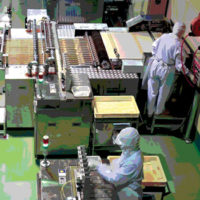ISO 22000: And the Beat Goes On

International Organization for Standardization (ISO) 22000 is a unique food safety management system standard. The standard is nonprescriptive since it describes the requirements for a food safety management system. However, the standard and the guidance standards do not define what specific actions an organization must take to meet these requirements. The organization must determine these actions and then show an auditor that these actions are effective in controlling the identified food safety hazards.
 Adoption of ISO 22000 is growing internationally. In 2007, approximately 4,000 standards were issued worldwide. Currently, the number of certifications has increased to approximately 18,000 certificates worldwide. The majority of certifications has been awarded to food processing operations in Asia and Europe. Table 1 presents the top 10 countries that have ISO 22000 certificates granted to food processors by country.
Adoption of ISO 22000 is growing internationally. In 2007, approximately 4,000 standards were issued worldwide. Currently, the number of certifications has increased to approximately 18,000 certificates worldwide. The majority of certifications has been awarded to food processing operations in Asia and Europe. Table 1 presents the top 10 countries that have ISO 22000 certificates granted to food processors by country.
In addition, over 2,680 Food Safety System Certification (FSSC) 22000 certificates have been awarded internationally, with 40 percent being awarded to sites in Europe, 30 percent to sites in the United States and 20 percent to sites in Asia. FSSC 22000 is a Global Food Safety Initiative (GFSI)-recognized food safety management audit scheme. It uses ISO 22000 and appropriate ISO 22002 standards to define the requirements for a food safety management system.
Since ISO 22000 is a nonprescriptive standard, it provides both opportunities and challenges to organizations that desire to implement the requirements. The primary opportunities focus on the fact that some companies with a highly developed food safety management system may be already meeting the standard’s requirements. However, the challenges are just the opposite of the opportunities. Organizations that want to implement ISO 22000 must have access to professionals who understand food safety systems so that the food safety management system can be properly designed and implemented.
The implementation process consists of three parts:
1. First, the organization must understand the requirements of the standard.
2. Second, it must understand what must be done to implement the standard’s requirements.
3. Third, the organization must develop a plan to meet the requirements of the standard.
 In response to market needs, ISO subcommittee (SC) 17[1] has been developing a number of standards and guidance publications to support the use of ISO 22000. Table 2 lists current and planned publications that support ISO 22000 in the ISO 22000 family of standards.
In response to market needs, ISO subcommittee (SC) 17[1] has been developing a number of standards and guidance publications to support the use of ISO 22000. Table 2 lists current and planned publications that support ISO 22000 in the ISO 22000 family of standards.
ISO published two booklets that were initially designed to provide technical assistance to help midsize and small businesses implement food safety management systems that conform to ISO 22000. These booklets are written to be useful for any company that desires to implement and maintain a food safety management system based on ISO 22000.
• ISO 22000: Food safety management systems: An easy to use checklist for small businesses: Are you ready? is also known as ISO 22000: Are you ready? The publication presents a detailed explanation of the auditable clauses on the standard. It is available in paper format, PDF format and CD-ROM.
• The second publication is How to use ISO 22000 food safety management systems. This publication provides guidance to organizations that desire to implement ISO 22000. It was written by a committee of ISO experts who have been actively involved in teaching and implementing ISO 22000. It will be published early in 2013. One key focus of the book is to explain the process approach that forms the structure of ISO 22000. Surak and Lorca[2] published an article on process audits in Food Safety Magazine.
Both books can be purchased for a nominal cost at the American National Standards Institute and ISO websites (www.ansi.org and www.iso.org/iso/home.html).
Expert Panels
SC 17 has formed an expert panel on the ISO 22000 family of standards. This panel consists of six experts representing Australia, Asia, Europe and North America. The panel will develop an official interpretation of the standards. The panel will not respond to questions on audit schemes such as FSSC 22000 and other GFSI-recognized audit schemes, or specific conditions an organization can use to meet the requirements of the ISO 22000 family of standards. The panel’s work will be published on the FAQ page that is part of the ISO management-system-for-food-safety website (www.iso.org/iso/tc34sc17home). This content is also located at www.myiso22000.com.
PRP Guidance Standards
Work has continued on the publication of ISO technical specifications to provide guidance on the prerequisite programs (PRPs) that organizations should implement. The PRPs are an essential part of the food safety management system in that they define the environment for the production of safe food. The subcommittee plan is to have a total of six guidance standards that cover the PRPs for the entire food chain.
In 2009, ISO published ISO/TS 22002-1:2009. This technical specification is the first standard in the ISO 22002 series and describes the PRPs required for food processing organizations. The standard was based on PAS 220:2008.
 ISO has just recently published the PRPs needed for catering operations. ISO/TS 22002-2:2013 was made available as of January 17, 2013. This standard is intended to be used by catering and foodservice organizations that include air catering organizations, and companies that provide foodservice operations, including school and industry dining rooms, healthcare facilities, hotels, restaurants, coffee shops, supermarkets and retail food stores. Table 3 provides an outline of the standard.
ISO has just recently published the PRPs needed for catering operations. ISO/TS 22002-2:2013 was made available as of January 17, 2013. This standard is intended to be used by catering and foodservice organizations that include air catering organizations, and companies that provide foodservice operations, including school and industry dining rooms, healthcare facilities, hotels, restaurants, coffee shops, supermarkets and retail food stores. Table 3 provides an outline of the standard.
Farming is the first step in the food chain. ISO 22002-3 describes the best practices that should be adopted that allow farmers to maintain a hygienic environment so they can do their part in ensuring on-farm hygiene.
 The standard is divided into three parts: common PRPs, PRPs specific for crop production and PRPs specific for animal production. Included in the animal production are PRPs for growing, handling and harvesting aquatic animals. Table 4 presents an outline of the standard’s requirements.
The standard is divided into three parts: common PRPs, PRPs specific for crop production and PRPs specific for animal production. Included in the animal production are PRPs for growing, handling and harvesting aquatic animals. Table 4 presents an outline of the standard’s requirements.
Currently, ISO SC 17 is actively developing two additional standards, one for food packaging and one for food transport and storage. The food packaging standard defines the requirements for establishing, implementing and maintaining PRPs for controlling food safety issues in the manufacture of food packaging materials. This standard should be published in 2013. The work on the transport and storage standard has just started, with publication scheduled for 2014. A feed production standard is expected to start in 2014.
New Work on the Horizon
ISO is revising ISO 22003, the auditing standard, and ISO 22004, the guidance standard for interpreting ISO 22000. All ISO standards must be reviewed once every 5 years. During this review process, the standards are renewed, revised or withdrawn. In 2010, ISO voted to renew the contents of ISO 22000. ISO will start revising this standard in 2014 or 2015.
 John G. Surak, Ph.D., is the principal of Surak and Associates and provides consulting for food safety and quality management systems, designing and implementing process control systems and implementing Six Sigma. He led the U.S. delegation to ISO committee meetings that developed ISO 22000. He can be reached at jgsurak@yahoo.com.
John G. Surak, Ph.D., is the principal of Surak and Associates and provides consulting for food safety and quality management systems, designing and implementing process control systems and implementing Six Sigma. He led the U.S. delegation to ISO committee meetings that developed ISO 22000. He can be reached at jgsurak@yahoo.com.
References
1. SC 17 is the ISO subcommittee responsible for managing the ISO 22000 family of standards. This SC is located within ISO Technical Committee 34, the food products technical committee.
2. Surak, J.G. and T.A. Lorca. 2007. Process audit for food safety. Food Safety Magazine 13(4):12–15.
Looking for a reprint of this article?
From high-res PDFs to custom plaques, order your copy today!






